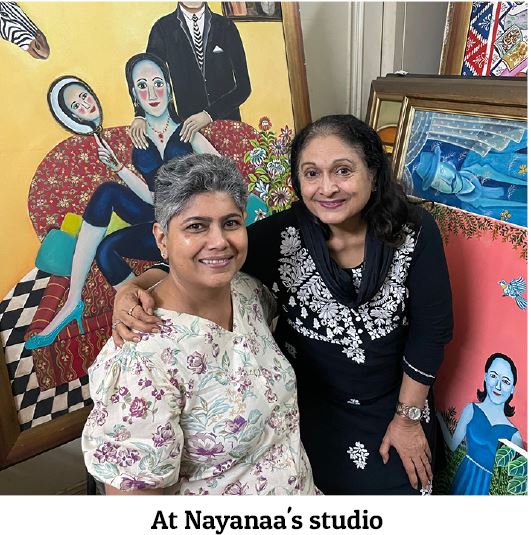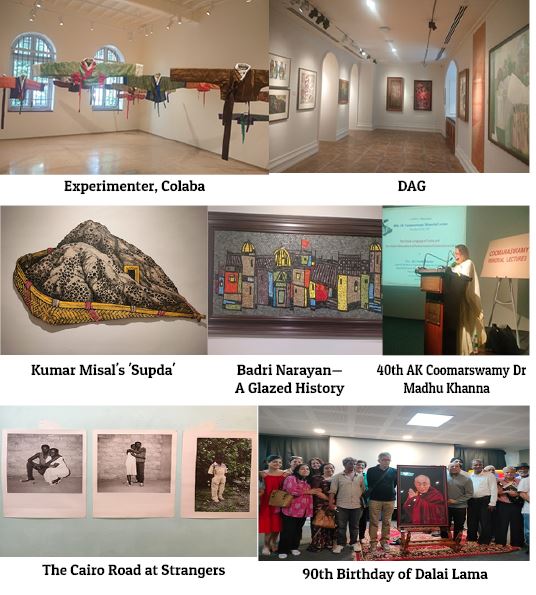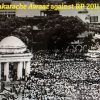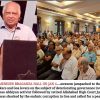Goa is abuzz with excitement as vintage bike and car owners, users, collectors and fans are decking […]

THE ART OF BEING A WARRIOR!By Joanne Pinto Pereira
JO-GO ART, July 12- July 18, 2025 July 11, 2025The wave of interest in textile traditions has swelled recently. Max City has a great history of textiles due to its location and India’s commercial capital. Almost every home had the Mill as part of their micropore and a member who brought food to the table from employment there. As a teenager, I recall 1977 being the disruptor with the Mill labour on strike. That changed the landscape and source of existence for the populace. Through all of this, it has been the handloom and craft tradition that has cast a spell on me.
Indian Textile Tradition
Simply fascinating. I have signed up for MAP’s online lecture series ‘Indian Textiles: Histories, Practices, Perspectives’, held every Saturday till 6 September 2025. Led by Mayank Mansingh Kaul, this series brings together 20 guest speakers and panelists, ranging from textile makers to scholars and practitioners. Lingering in my memory is Lavina Baldota’s collection displayed over the expanse of ‘Sutr Santati’ at NGMA, Mumbai. The offsites were a deep dive into the world of textiles and associated crafts that have been documented. I am stoked to reference books like ‘Threads & Voices,” edited by Laila Tyabji. More stories coming up!
Finding the Naya in Art
Thrive, don’t survive is the manTRA. It’s ART in daily living that seems to be the prescription that works. For most of the women creators, age is a number. They stay relevant while the world plods on. It must be the creative stimulation and expression that keeps them agile and on top of being Alive. It’s what you can put down as the wonderment of Art.
Nayanaa Kanodia’s studio has stacks of her artworks in an orderly lineup. It’s like stepping into a world that has the best of Art Deco, unsullied Bombay of yore charm, and her evolution over the last four-plus decades. The turning point was her first showing in 1983, at Cymrosa, Breach Candy. The self-taught artist was determined to spend every free moment from home and hearth to catch up with her zest to study. Her thirst to learn led her to be a pioneer of ‘L’Art Naif’ in India.
Seriously Whimsy
Her canvas is alive with colour and tiny details. A happy reverie, so to speak. While you may dwell on the multitude of avian species or the urban caprice, the social messages are there for you to pick up. Our fragile ecosystems and environment surface in a playful manner. A seemingly impossible collaboration of Man and Nature provides a juxtaposition to our sensibilities. You find yourself asking why and why not simultaneously.
The female protagonist is very much at ease as she claims her space, naturally. It is not a misnomer in a manmade hierarchy when her foot nudges her spouse. You see a fulfilled equation, tender togetherness.
You identify with the sense of social familiarity so delightfully relayed. It is as if you walk through a fairy tale cover that you can’t get enough of. Born in 1950, Nayanaa is a beacon for not just women but a call for each one to elevate the daily ordinary. It’s how you view it, entirely.
The world of Visual Art has gained a lot thanks to Nayanaa, an economics student by academia who chose to pursue her creative trajectory, mindfully.

ANT leap
My ANT hop on 10th fulfilled an ambitious trail of Art and Charlie with Kumar Misal’s endearing ‘supda’ work, DAG’s latest ‘Deconstructed Realms on India’s Tryst with Cubism on view and in catalogue with three essays. Experimenter Colaba’s Kallol Datta’s solo Volume IV: Truths, Half-Truths, Half Lies, Lies with Amal Khalaf, co-curator, Sharjah Biennial 16 & Director of Programmes, Cubitt, London uses elaborate kimono and richly embroidered fabric to convey the hidden social vocabulary of garments
Again, down the alley of Colaba Strangers House Gallery hosts a new exhibition ‘The Cairo Road’ curated by Sana Ginwalla in collaboration with Everyday Lusaka Gallery & Zambia Belonging. Alick Phiri, Daudi M. Yves, Lawrence Chikwa, Sana Ginwalla, Kalinosi Mutale, and Maingaila Muvundika exhibit avant-garde art searching trajectories in storytelling and materiality from Zambia. It requires a day in itself to explore each artist’s work.
On until 12th September 2025
Roots of the Earth’, featuring Prabhakar Kamble and Akshay Mahajan previewed on ANT at Jhaveri Contemporary with Sumesh Menon leading the walkthrough on the 11th.
Shireen Gandhy brings the warmth back to mid-monsoon July’s Art Night Thursday, Chemould Prescott Road is hosting Naresh Kumar’s exhibition, ‘Act of Republic. Through the lens of migration and negotiation, each attempt to return to Bombay results in him claiming a small piece of his sky. The process ties together the chessboard of expression on old telephone book pages. Their installation setup social media reel amplified the ANT excitement! And the showing delivered the balance of freedom and belonging that we and Naresh struggle with.
Galerie Isa is the ANT hot crawl favourite with multiple artists in ‘Surface, Time, Memory, Illusion’ curated by Jamila Adeli. While Art Basel’s footprint has extended to Qatar, our Mumbai Art vibes are compelling.
The intense showstopper was the 40th A K Coomaraswamy commemorative lecture at CSMVS by Dr Madhu Khanna. Her knowledge of the subject of Tantra and its influence on contemporary Art required a series of lectures to do justice to it.
Staying Real
Noteworthy in the Art bounty is Fulcrum Art Gallery staying the course with “Courage in Crossfire” curated by Bandhu Prasad Aleyamma. Over the weekend, the space pays cinematic tribute to Independent Journalists who risk their lives to bring us coverage. More power to them, Ayesha Aggarwal, her infant gallery, and the brave hearts.
Dalai Lama XIV’s 90th
Some stories move mountains — this one moved the world. Martin Scorsese tells the story of the 14th Dalai Lama’s early life and exile from Tibet through his documentary ‘Kundun.’ The film was screened at Title Waves in Mumbai and at Jackfruit Tree Café, Assagao, to celebrate the 90th birthday, on July 6, 2025, of His Holiness. This date is one of the most important dates in the Tibetan calendar and is celebrated globally as World Tibet Day. While the spotlight is on the spiritual leader, it is a timeless tribute to the simply beautiful ethos of Tibet. Organised by Friends of Tibet, the struggles of the Tibetans are conveyed through various activities to engage the world’s sensibilities.
Art Learnings
The Art of Learning about Art is a learning in itself. As Life unfolds, I submit to the Zen belief that no moment in life is to be more important than any other moment. But then the Art addict in me kicks in, and I surrender to feed it the day after ANT. When Art veteran practitioners like Bose K, Reena Kallat share their learnings at Dr Shantilal K. Somaiya School of Art collab with Jehangir Nicholson Art Foundation, I listen. It also allows me to catch up with fellow Chemburkar, Badri Narayan’s exhibition on view at the JNAF Gallery, CSMVS.
Acquire Art or not?
In the ’80s, Pundole Art Gallery at Flora Fountain had Badri’s work exhibited. There were these two frames of Ganesha at Rs 4000. As a features writer, then, it meant a few months’ salary, but more importantly, acquisition is a responsibility that I was not ready for. It found homes that I recently traced. The question is, would I sell my Vignaharta at a multiple value? I made peace with my old learning, ‘Art consumption is a personal choice’. I stay content with ownership of the work in the moment as I gallery hop. My response has stayed constant: “If the work haunts you, acquire it.” Living with what you love is a plus over owning equity for sure!
A Glazed History
Badri Narayan and the Vitrum Studio is the first retrospective showcase of hand-painted ceramics and glass mosaics of Mumbai’s Vitrum Studio in post-Independence Mumbai.
Founded by Jewish war émigré artists Simon and Hanna Lifschutz, Vitrum Studio (1957-1974) operated as a unique creative space offering artists access to materials, a kiln, technical support, and an outlet to sell their work. The show highlights this vital link between Badri and the Vitrum Studio to Indian modernism in Visual Art. As explained in her note, Puja Vaish, Curator and Director of JNAF, the studio attracted artists from Sir J.J. School of Art and beyond. At the heart of the exhibition is artist Badri Narayan, the only artist to be associated with the studio from its inception to its closure. His works in glass mosaic and painted ceramic formed a significant part of Vitrum’s creative output, many of which are on display alongside his paintings from the JNAF collection. In addition, the exhibition draws on the significant collection of Haresh Mehta, along with loans from the Godrej and Pundole families.
Art and more
I’ve been known to break a neck to follow Art. But now the sense of adventure beckons. I am headed to soak in Monsoon finery in and around what is left of our natural beauty. More about it soon, until then, Mog asum!














